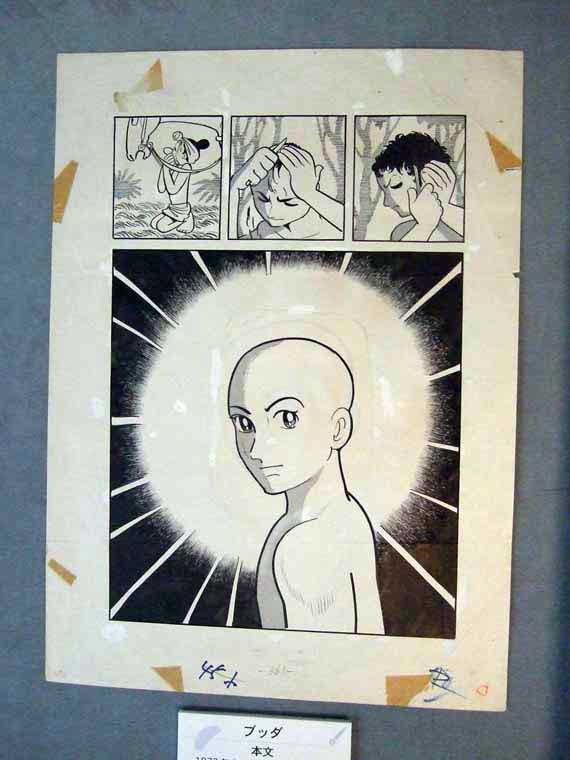#5. Buddha Volume 1: Kapilavastu HC, by Osamu Tezuka. Published by Vertical Inc., October 2003.

When I think of how and why Osamu Tezuka’s Buddha was a milestone of the last decade, I come up with a laundry list of ideas. It’s incredibly tempting to just jot them down, point form, and let it wash over you. But I am a writer, and so I will write about it a little.
In the summer of 2003, my mind was quite happily blown by a book called Yukiko’s Spinach, a French/Japanese hybrid graphic novel by Frederic Boilet, published in English by the UK outfit Fanfare. Yukiko’s Spinach is either autobiography or drawn so closely from events true-to-life that it doesn’t matter if it’s not; it’s about a French comics artist in a doomed relationship with a Japanese girl as they both live together in Tokyo. It is heavily photo referenced, with strong black lines and shadows over top of blurred-out photographs and greytones, giving the entire effort an ethereal quality. It was printed on heavy, glossy paper, and weighed in at a little over 200 pages. The cover was on thick, coated-matte stock, and it had French Flaps! It cost like $28 or something (Canadian). It was manga, but also not manga, and it dealt with an adult relationship that slowly unraveled over its length, in a matter-of-fact way. It, as an object, and as a story, was revelatory to me. Fanfare had introduced the world to “Nouvelle Manga”, a movement of work that sought to blend French, Japanese, and American comics ideals to create something unique, exemplifying the strengths of all three, for a more mature and sophisticated audience. Fanfare would follow Yukiko’s Spinach up over the next 7 years by producing, book-for-book, the single strongest line of material out of any publisher working in English. I mean, it helps if you only do a book (or occasionally two) a year, but they’ve got maybe one book in their library that I’d consider mediocre, and everything else is either above-average or outright excellent. Drop as much money as you can acquiring their backlist.
That said, the impact of Buddha blows it all away.
Osamu Tezuka is called “The God of Manga”. Sure, that’s over-the-top, and particularly coming from a western point of view, particularly in 2003 when the sum-total of his work in English was a handful of volumes of Astro Boy, the may-as-well-be-out-of-print Adolf and a couple of the early volumes of Phoenix. The title just seemed… quaint. Like “Oh, yeah, the Japanese really love this Tezuka guy, he made all those kids comics like Astro Boy and Kimba, but whatever.” And you’d hear from people that he had drawn tens of thousands of pages of manga, had over 700 different works, and it was like “yeah, we get it, he’s popular in Japan” and that was that. You couldn’t tell people, and the material wasn’t available to show them either. I mean, I accepted it on faith, but that’s all it was. Astro Boy‘s great, but…
When it was announced that a young publisher from outside of the comics market would be releasing an 8 volume hardcover series comprising well over 2000 pages of adult-focussed material by Tezuka, it was jaw-dropping. First and foremost, it was a ‘real’ publisher doing the publishing. Vertical was known for producing English-language translations of Japanese novels, with striking cover designs by graphic design superstar Chip Kidd. They were not Tokyopop, or Viz, or even Marvel or DC. These were people in the business of putting out great looking English editions of foreign work, and they decided that was going to include manga as well. They also decided that it would include the most important manga they could find, and that meant Tezuka. But how do you choose which Tezuka manga out of tens of thousands of pages and over 700 different works…? You go for the one with the grandest scope of course, and that’s the one that details the life story of The Buddha. Now that’s a deity with name-recognition!
So the whole summer, the industry (and manga fans like myself) are buzzing. Buddha! Buddha! Buddha! Chip Kidd! Buddha! It was exciting. Not just because it was a ‘real’ publisher publishing manga (and thereby giving the whole medium of comics recognition), not just because Chip Kidd had designed beautiful books, more beautiful than any other manga title (or almost any non-manga title) published to date. Not even because this was the first major comics biography of a religious figure, and the book would doubtless find an audience far otuside the standard confines of the comics industry, acting as a spearhead into the little-travelled world of Comics For Grown-Ups. I mean, sure, every single one of those things happened. But that wasn’t why we were buzzing… It was because now we (manga fans) could finally prove the worth of Osamu Tezuka to the doubters, to our friends, to anyone who would listen (whether they cared or not).
Buddha is not Tezuka’s strongest work, nor is it my favourite by him. I’m partial to Phoenix Volume 4. My friend Jason (and the rest of the world) seems to think it’s Phoenix Volume 5 that’s the pinnacle of English-language Tezuka work. A few Johnny-come-latelys even prefer Ode To Kirihito or MW. But Buddha? Buddha was more than ‘enough’. It’s epic.
The first volume of Buddha does not contain The Buddha, except as a baby, born in the last 10 pages of the volume. The entire first volume of the book is prologue; developing the setting, the characters, the tone, hinting at the plot. A number of fictional characters are created to explain the caste system that gripped India and South Asia, to create sympathy and understanding, to ease readers into an unfamiliar world. Lots happens of course, wars, love, betrayal. It’s a great book all on its own with a complete narrative arc, fully-developed characters, a tear-jerker ending, the whole thing. 250 pages. Prologue.
The most important thing about Buddha, the switch it flipped in the minds of everyone who read it, or even heard about it? It had a larger scope, a higher ambition, than 99% of comics released before it. And it was by Osamu Tezuka. And it was originally published in 1972.

Buddha cemented the name of Tezuka in the minds of the denizens of the North American comics industry, but also the wider literary world, which was just beginning to dabble in reviewing and discussing these grown-up comic books. Buddha was irresistible in that regard, as the subject (Buddhism!) was hot! Buddha was touted as a great “way in” to understanding Buddhism, and with the review came the attendant praise and acclaim for Tezuka, further raising his profile. Best of all? North America loves memoir and biography, and looking at the graphic critical darlings of the last 10 years like Persepolis, Fun Home, Blankets, etc., it’s easy to see how something like Buddha would fit in nicely.
There were drawbacks of course, weaknesses in the work. The biggest is that, despite being far ahead of its time in 1972, social mores had changed in 30 years (and Japan and America never quite had the same social mores to begin with…), and while the work wasn’t as problematic in that regard as other earlier Tezuka works, even as a historical work some of its depictions were dated and off-putting. Buddha was also one of Tezuka’s earliest attempts to do work for grownups, and although it does have a depth and maturity Tezuka as an author was still preoccupied with the idea of his audience of young children discovering this work, and so he would constantly diffuse scenes that got too dark, depressing, or serious with slapstick humour or deformed characters, occasionally deflating a scene entirely. The length of the work, one of its most monumental assets, was also considered a detriment by many. 8 volumes at $24.95 is $200! That’s a lot of scratch to drop to get one comic book story. And The Buddha isn’t even in the first one!
The series did well though. It sold out in hardcover, multiple printings on the first 6 volumes too. It was a critical darling. And it was the first high-profile, successful, mature manga. Fanfare UK was already moving to publish more mature works, and mature, outsider, and underground manga had been published by Viz, Blast Books, and Fantagraphics, for years at that point. But none of it was able to break through, out of the indifference of the general market who wanted their manga shonen (or shoujo) and exciting and pretty, or else were completely disinterested in manga altogether (often with prejudice). Buddha created a market for manga for grown-ups, when nothing else to that point had worked. That’s pretty goddamned amazing.
It almost didn’t get finished, by the way. Right around volume 5 or 6 there was a pretty big delay in the publishing. Vertical was having severe cashflow problems, it was all over the book industry trade papers, and it was joked (meanly!) that we might never find out if The Buddha would attain enlightenment or not! Vertical had another mis-step when they solicited and began promoting inexpensive softcover editions of the series–in the middle of the hardcover release! Nothing kills a serialization faster than being told “Hey there’s a cheaper version coming out in a few months! Less than half the price!” In Vertical’s defence, the $9.95 paperback editions were going to be differently broken-up than the HCs, 12 volumes total instead of 8, I think (matching one of the Japanese releases). And they were in a cash crunch, one that some quick paperback money would have helped to alleviate. But yeah, let’s just say it’s a very good thing indeed that they decided to hold off on that release entirely, opting to do the series in an 8 volume softcover edition beginning in 2006… after the end of the hardcover releases.
Since then, Vertical has released a dozen more books by Osamu Tezuka, including Ode To Kirihito, MW, Apollo’s Song, the 3 volume Dororo, and 9 volumes of a 13-volume release of Tezuka’s second-most popular creation, Black Jack. Viz finished their release of Phoenix with all 12 volumes in print for a brief, fleeting moment, before volume 2 went out of print at the end of 2009 (hopefully only temporarily). Dark Horse released a number of very early works by Tezuka, more historical curiosities than anything else, including Metropolis, The Lost World, and Next World 1 & 2. DMP jumped in in 2009 with Swallowing The Earth, possibly the first outright bad Tezuka comic released into English. That’s it’s own sort of milestone I guess, but not one I’ll be noting here. Those and the afformentioned Astro Boy and Adolf make up the entirety of Tezuka’s works translated into English, about 70 trade paperbacks out of hundreds and hundreds in print in Japanese. Hopefully, with more to come.

Art: Top: Buddha Volume 1: Kapilavastu Hardcover Cover Image, published by Vertical Inc. Art by Osamu Tezuka, design by Chip Kidd. Middle: The spines of Buddha Volume 1-8 formed a larger image of the 3 periods of The Buddha’s life. Art by Tezuka, design by Kidd. Bottom: An original page of art from Buddha, by Osamu Tezuka. Taken at the Tezuka Museum. Photo by Christopher Butcher.
-o+O+o-
Tomorrow: #6, #7, and #8!
– Christopher!


There were also a couple of volumes of Black Jack that Viz released in the ’90s. Those were my first exposure to Tezuka.
Darnit, knew I was forgetting one. Thanks Mr. Murray.
I know there was also that super-rare translation of Crime & Punishment too, but… flow and all. Yeah, I’ll ammend that at some point.
Crime and Punishment and Princess Knight were both publisehd by Kondansha in bilingual editions in Japan weren’t they? I had a friend who had the first Princess Knight volume, and it was neat to read that. Too bad they’re out of print.
I guess there might also be singaporean english translations of some of his stuff? I know there’s some stuff in Singapore you can’t get anywhere else in English (Doraemon).
Great post, Chris! Good points all around on the importance of this title.
Also, I just have to say it, I hated Yukiko’s Spinach (both art & story).
Excellent post. Picked up the first volume of Buddha last weekend… really looking forward to reading it.
Such pretty spine art! Makes me sad I never completed my set. Maybe it’s not too late to amend that.
Hello everyone. Chris’ pal, Jason, here. It’s actually the fouth volume of PHOENIX that I think is the best thing I’ve read by him – the masterful and heartbreaking “KARMA”.
Have a great new year, gang.
– Jay
As Jason just noted, Phoenix Volume 4 (“Karma,” the one about the sculptors set in ancient Japan) is commonly agreed upon as the best of Tezuka’s work available in English. Volume 5 (“Resurrection,” the sci-fi one about the guy whose brain is operated on) is good as well, but I’ve never really heard it frequently brought up as a contender for “the best.” I was always partial to the once again out of print Phoenix Volume 2 (“Future”) since that was the first one I ever read (and despite being Volume 2, the first Viz put out). The original edition of “Future” was in a larger format than the rest with nothing to denote it was “Volume 2” since presumably its success or failure would determine whether the rest of Phoenix would get released. I bought it on a whim when I saw it in the local comicbook shop back when I used to bother even going to comicbook shops.
Interesting that you note Swallowing the Earth as the first outright bad Tezuka comic to get released in English. I’ve still not read beyond the foreword by super translator, Tezuka expert, and Revolver Ocelot lookalike Fred Schodt, which points out that Swallowing the Earth was originally a satire. Presumably, many of the satirical elements have since come true since publication and thus would no longer be seen as such if one were to just read the thing. With that kind of disclaimer, I’m expecting something along the lines of Network.
For anyone looking for more information on how the publication of Phoenix in English came about, along with details on early prototype publications of Karma and the collaboration with Tezuka Production, please check out my in-depth interview from 2008 with Fred Schodt:
http://electricantzine.com/ea1-fred.html
Yeah, like Jason and Daryl said, I totally flubbed that sentence. Everyone thinks Volume 4, Karma, is the best, but the inventiveness of the visual storytelling in the last half of volume 3, always spoke more to me personally… I’ll go ahead and fix it.